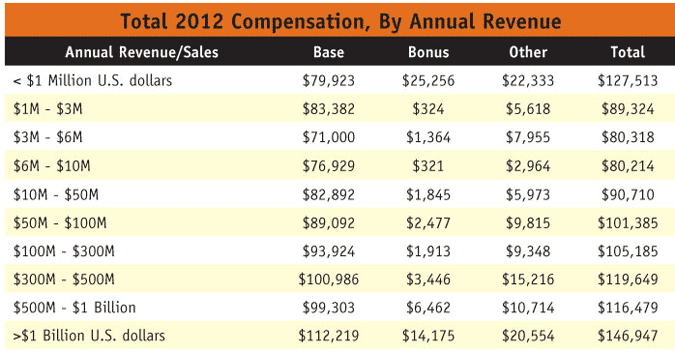Happy (mostly) to be here
For the fourth consecutive year, Quirk’s has surveyed its audience of client-side researchers to take the temperature of the industry by tracking salary trends. While the 2010 and 2011 salary survey results showcased the market research industry’s resiliency in a tough economy, 2012 seems to be a further improvement, with results indicating that client-side researchers are earning more, are sufficiently satisfied and more likely than ever to stay put.
The 2012 salary survey data is based on completed surveys from 1,287 full-time client-side researchers – our largest respondent pool to date. That level of response allowed us to achieve an interval of 2.6 at the 95 percent confidence level.
Different from last year, however, is the breakdown of job classifications. The 2010 and 2011 results indicated that those with the title senior vice president or vice president earned tens of thousands of dollars more than owners, presidents and CEOs ($185,500 vs. $152,000 in 2011; $180,182 vs. $124,364 in 2010). These curious findings inspired us to take a closer look at these big-money titles.
The 2012 salary survey separated owners and partners from presidents, CEOs and COOs and found that owners and partners are earning almost double that of presidents, CEOs and COOs ($293,818 vs. $149,200). A difference of almost $150,000 is dramatic but not entirely befuddling, as it stands to reason that company owners and partners would be the best-compensated and the most highly-invested. It would appear that in the previous years, grouping owners with presidents and CEOs may have inaccurately inflated the salaries of presidents and CEOs.
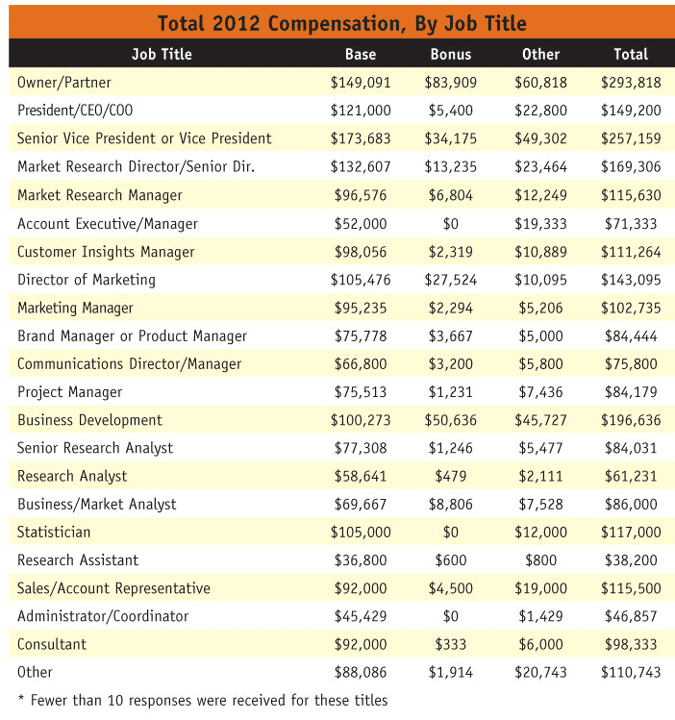
Greater divide
However, we see now that there’s an even greater divide between the pay of the head honcho and the No. 2. Senior vice presidents and vice presidents are making on average over $100,000 more than those with a president/CEO/COO title ($257,159 vs. $149,200). These results have held fast over the past three years, though without any conclusive reason as to why. This could be unique to our sample and further analysis is needed. Though it is worth considering whether high-profile positions like president and CEO come with the prestige but not the pay.
Aside from these positions at the very top, the highest-earning client-side job titles are market research director or senior director ($169,306), director of marketing ($143,095) and business development ($196,636 and higher than that of president/CEO/COO). Nearly half of all respondents classified their position as market research director or senior director (20 percent) or market research manager (29 percent). The next-most-selected title was senior research analyst at 10 percent, followed by research analyst at 9 percent.
Overall, client-side researchers are earning more, as the grand total for 2012 compensation by industry was $124,009, compared to $109,447 in 2011. The technology/IT/Web industry had the highest average at $145,510, followed by consulting at $144,095; food/beverage at $143,721; advertising/public relations at $140,424; and manufacturing at $140,093.
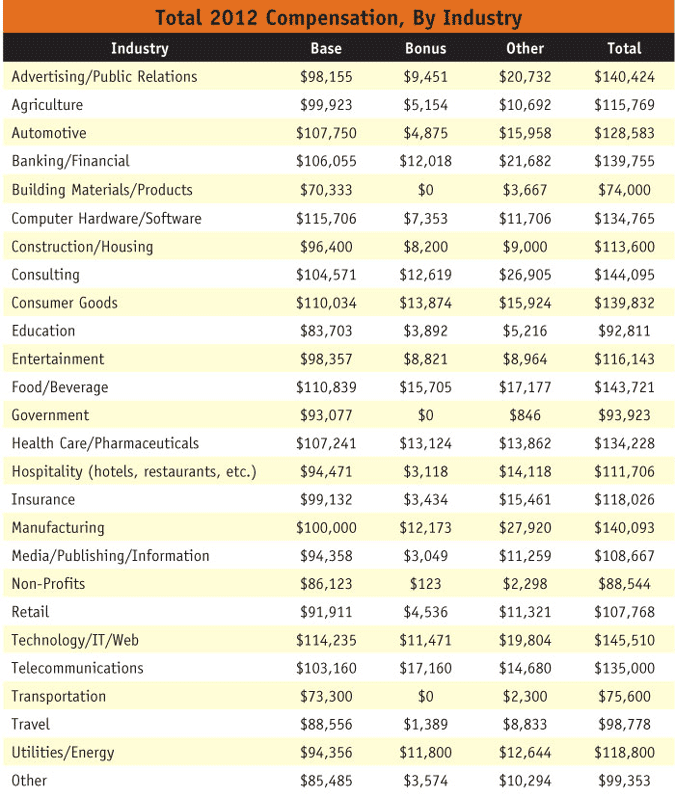
Domestically, the biggest bucks are made on the coasts, specifically the West Coast (average salary of $145,548) and New England (average salary of $140,424 in the Northeast and $143,384 in the mid-Atlantic region). Client-side researchers working internationally reported the highest salary, with $168,400 in Africa and $157,571 in the Middle East, though fewer than 10 responses were gathered for each of those regions.
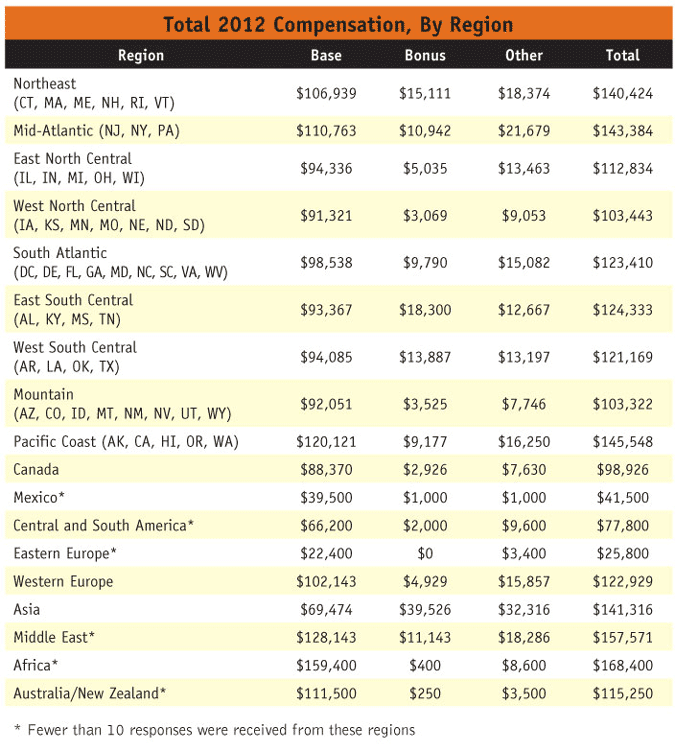
The future looks bright for client-side earnings. In 2011, only 4 percent of respondents said that their base salary decreased in 2011 and the rest reported that their salary increased or stayed the same. The good news continues in 2012 as 3.77 percent of respondents reported a decrease in salary. The same percentage (25 percent) of respondents’ salaries stayed the same as in 2011 and the rest increased. While only 5.66 percent reported a salary increase of more than 10 percent, down from 8 percent in 2011, at least the majority of corporate researchers’ salaries are headed in the right direction.
Unfortunately, bonuses took a slight hit as 18 percent reported a bonus decrease in 2012, compared to 10 percent in 2011. The percentage of researchers who reported a bonus increase stayed steady around 35 percent and those whose bonuses remained the same dropped from 54 percent in 2011 to 48 percent in 2012. The verbatim responses echoed these findings, confirming that bonuses are down:
“No bonuses were given in 2011. Received around 10 percent in past years.”
“I work for a government agency and have not had a raise in five years.”
“No raise or bonus in five years!”
“No bonuses were paid out due to poor company performance but I remain eligible for a bonus in 2012, depending on company performance.”
“Salary freeze and furloughs since 2009.”
And simply:
“I am a slave...”
Satisfaction about the same
But despite the vanishing bonus, satisfaction has stayed about the same overall, with 73 percent of respondents saying that they are somewhat satisfied (20 percent); satisfied (36 percent); or very satisfied (17 percent) with current employment, compared to 71 percent in 2011. Once again, the 2012 results indicate no link between job satisfaction and pay, only that those who are the most indifferent are paid the least. Those who gave a neutral response to the question of job satisfaction earned an average of $113,064 and those who said they were somewhat dissatisfied earned $107,746, compared to those who were very dissatisfied earning $125,459; dissatisfied $128,726; satisfied $125,514; and very satisfied $128,775. It seems money can’t buy you love or job satisfaction, at least not in this industry!
In general, corporate researchers are less likely to seek new employment in 2012 than they were in 2011, with 15 percent somewhat likely to seek new employment; 7 percent likely; and 12 percent very likely. This is a 7 percent decrease from 2011, where 41 percent of respondents reported being somewhat likely, likely or very likely to seek new employment but is still an increase over the 2010 results where only 10 percent were very likely to seek new employment. Overall, though, client-side researchers seem more content, as 21 percent are very unlikely to seek new employment, compared to 13 percent in 2011. Of course, another driver could be the fear of trying to find a new job in a tight employment market. Though in looking at some of the verbatims, many respondents indicated they were fairly new to their current positions, so perhaps job-switching isn’t that difficult these days.
Additionally, there does not appear to be a correlation between how likely a researcher is to seek new employment and salary, as the average salary of someone very likely to seek new employment is over $10,000 higher than someone very unlikely to seek new employment ($120,787 vs. $109,632). The highest-paid researchers fall somewhere in the middle, with an average salary of $130,435 for those undecided about seeking new employment.
For those who do venture out looking for a new job, the percentage of companies likely to hire additional market research employees in 2012 is almost the same as 2011, with 16 percent somewhat likely to hire additional employees; 10 percent likely; and 12 percent very likely. Unfortunately, it is still generally less likely for companies to bring on additional researchers, as 52 percent are very unlikely, unlikely or somewhat unlikely to do so, compared to 38 percent of companies very likely, likely or somewhat likely.
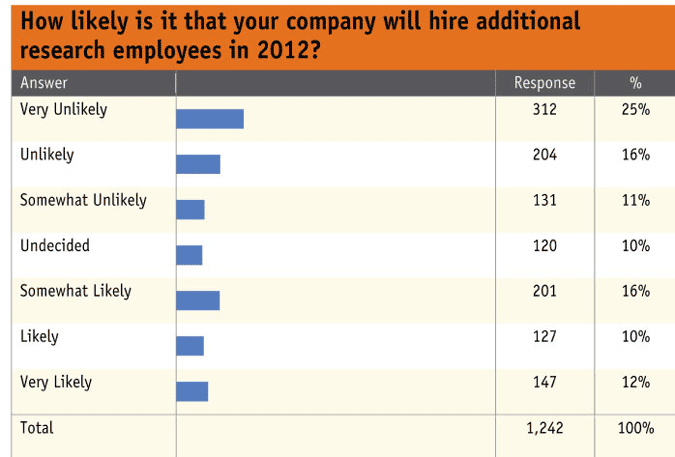
Experience and earning
In terms of qualifications, 2012 again showed a strong connection between experience and earning. The average salary for researchers with less than one year of experience is $68,417, increasing to more than double that for researchers with over 25 years of experience ($166,732). At 16 or more years of experience, researchers today could expect to earn over $160,000 per year.
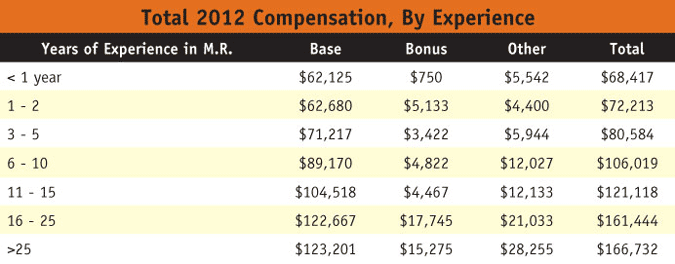
There is also a pattern similar to the one seen in 2011 where more education does yield higher salaries, with a Ph.D.-holder earning over $40,000 more than a researcher with a high-school diploma and $30,000 more than someone with a bachelor’s degree ($141,462 with a Ph.D. vs. $100,100 with a high-school diploma and $111,326 with a college education). Fifty-seven percent of client-side researchers reported having a master’s degree, the average salary for which is $130,839, up from $113,199 in 2011.

So if researchers are missing the bonus this year, they would be wise to further their education. However, certification courses don’t seem to carry the same weight. Results showed a difference of only approximately $4,000 in favor of those who hold a market research certification, which 20 percent of respondents reported having.
Loose and lithe
As the research industry continues to battle the recession and keep up with evolving technologies, researchers are aware that success depends greatly on their ability to stay loose and lithe. When asked about what skill set marketing researchers will need to possess in the coming years, the overarching theme seemed to be one of flexibility and adaptability:
“Innovation. Eagerness to try new methods.”
“A large toolkit, knowing right method for problem (vs. an all-encompassing approach).”
“Flexibility with the continued presence of technology and social media impacting our companies, decision-making and research protocol and process.”
“Adaptability to new methodologies and ‘non-panel’ data sources (e.g., customer database, social, etc.).”
“Ability to adapt quickly to ever-changing business environment while also educating their customers on the importance of marketing research as a component that is necessary for overall business growth.”
“Adaptability and analytical skills.”
Slow but sure
The client-side salary survey results again show that research is on a slow but sure course for improvement, keeping its strong foothold in industries of all stripes. And with client-side researchers well aware of what’s required of them to keep up with the ever-changing landscape – thanks to new methods and technologies cropping up left and right – it’s exciting to think about what could be on the horizon.
The June 25th Quirk's e-newsletter will feature an article on the vendor-side salary survey. Visit quirks.com/salaries.aspx for a breakdown of compensation for client- and provider-side research job titles, including crosstabs by age, gender, location and more.
